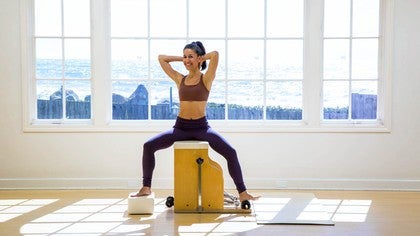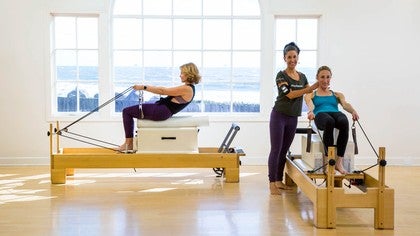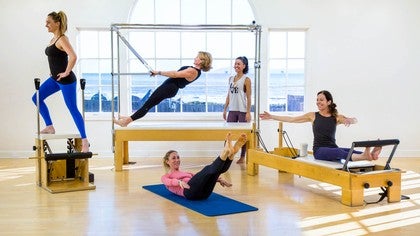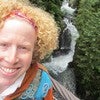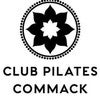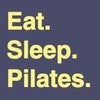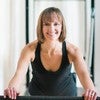Description
About This Video
Transcript
Read Full Transcript
Hi. So we are here at Pilates Anytime, still. And we're going to do a short chair workout that is really going to focus on again, footwork, foot integration, and spine articulation and a little more weight-bearing now with the exercises just to again, keep increasing function. So I'm gonna, you want the pedal to be on the heavier side but not so heavy that it feels like a struggle it's finding that fine line. So I've got two heavy springs all the way at the top.
I'm just gonna bring one down to the middle. And so it's still on the heavy side, but not completely at the top. And having the seat at the edge, and I'll just start with the heels on the pedal about hip width apart. Again, that narrow part or aspect of the hip. The sitting bone.
I'm just gonna press it all the way down, and I'm intentionally sitting pretty close to the edge so that I can feel the edge of the chair now at that area where the thigh kind of starts to meet the pelvis. By no means though do you wanna feel like you're about to fall off. You definitely wanna feel like you're solid there. And then put the hands on the pelvis and just notice that vertical orientation and notice how hard your legs are working to press that pedal down, and see if you can let up, ease up on some of that effort and still manage to keep the pedal down. So that you start to get the effort out of the legs a little bit and notice if that moves the energy around.
We'll just take a deep inhale here to prepare. (inhaling deeply) And exhaling. And it's a little different to start a class in a seated position because I'm not getting the feedback from the floor as far as where my head, shoulders and hips are so in that way it makes it a little bit more of an advanced practice when you start that way. So I'm gonna use my hands since I don't have a mat giving me information and I just wanna feel where my ears are, notice that they're sitting over the shoulders, notice that the shoulders are sitting over the ribs softening through the heart. And feeling how the ribs are sitting on top of the pelvis and again, that the pelvis is in a more or less vertical orientation.
So I can feel my sitting bones against the chair. And again I'm going to inhale while I'm here. And as I exhale allowing the pedal to bring my legs up and I'm keeping my fingers at the crease of my hips so that I can feel the movement. Kind of feeling how my thigh rolls around my fingers there. I also like to feel and sense the tone of the tissues around my hip socket.
Exhale as you press down. Inhale as it comes up. (exhaling deeply) (inhaling deeply) (exhaling deeply) (inhaling deeply) (exhaling deeply) And I'm just gonna do two more here. And while we're moving, again, keep noticing also the back side of the pelvis against the edge of the chair. Then I'll bring the balls of the feet onto the pedal, lifting the heels up high and then pressing down that way and noticing how that might really change the sensation through the lower abdominal area.
Especially when we're trying to maintain the height through the heel and I can feel it not just through the front but also how it wraps around to the back. It's like the entire core set of the torso really just got switched on by changing the foot position. (exhaling deeply) And again I wanna keep that awareness of my crown and sometimes it's a good idea to press down on it 'cause these things can be kind of vague. So just giving a little pressure to the crown of the head, noticing where the ears are, sitting on top of the shoulders, the ribcage softening down yet keeping the length. So it's, so much of approaching the work this way is about finding the alignment and then relaxing around it, so that we don't feel like we have to hold ourselves together so much but realizing that it really doesn't take that much effort once we find the relationships and how to stack things up on top of each other.
We'll just do one more of these. And then we'll bring the pedal all the way back up, I'm keeping some tone on the springs. Let's take it wide apart now, and this time letting it come up even a little bit higher. If we can bring it all the way up that's great. And what I mean by if we can is if we're able to maintain that same vertical alignment of the pelvis.
Let it come all the way up. If you find that when your knees come all the way up it starts to change your pelvis position, then don't let the legs come up that high. (exhaling deeply) Exhale as you press down. Inhale as it comes up. (exhaling deeply) As you breathe notice the feeling around the abdominals.
When you inhale, allow it to feel a bit soft. Exhaling as we press down. (exhaling deeply) So almost thinking as I inhale, my legs come up, my sitting bones spread apart. As I exhale, my feet push down, my sitting bones come together. Not because I'm doing anything other than breathing and moving at my hips, but that's just kind of following along with the rhythm at the base of the spine.
(exhaling deeply) Last one. (exhaling deeply) Keeping the feet wide now, we're gonna switch on to the balls of the feet and again, lift those heels up high. Exhale pressing down. You wanna make sure that you've got good footing there on the pedal. Inhale rising back up.
(exhaling deeply) So you might find that with the heels elevated keep prioritizing those heels, staying up high. The knees come up even higher, which means we're getting more movement at the hip. And again, that's really great as long as it feels great through the hip socket and as long as we're able to keep that vertical hip orientation or pelvic orientation rather. We'll just do this one more time. (exhaling deeply) And last one.
Press it all the way down. Now this time while it's down, just kind of shift your body weight forward. We're gonna bring our heels back on the pedal. And again, turning out wide. Now this time we're gonna keep that pedal down, let the knees turn out as we send the heart forward.
Inhale and come up. Exhale push down through the heels to help roll the pelvis back, and let that help round the spine. So inhaling the thighs turn out, and we're keeping that pressure consistent down through the heels, exhaling as the knees turn in. It's that same moment that rolls the pelvis back and the movement travels up through the crown. Inhaling to arch.
Exhaling to curl. Definitely inspired from gyrotonic. It's basically a seated cat cow stretch. Fun party tricks and great things to do when you're sitting at a desk for a while. (exhaling deeply) (inhaling deeply) It is interesting to do it too when the floor is coming up from under you, right?
It really helps us keep that pressure downward. Whoops speaking of it. It wants to come up. Last one. (exhaling deeply) Heels start to slide and now we're going to bring the pedal up.
Send the knees out. Lift the heart. Push back down. You wanna keep repositioning those heels so that they don't slip off. Turn the hips in.
Curl through the spine. Round, bring it in. Open the thighs. Let the pelvis arch. The spine travels too.
So again, think of it starts at your feet. It travels into your pelvis and up through your spine and then you let the hips come up again it starts at your hips, travels through the spine and we push down. Three more. Little more fluid. (exhaling deeply) (inhaling deeply) (exhaling deeply) (inhaling deeply) (exhaling deeply) And reverse.
(exhaling deeply) Thighs turn out. Arching through the spine and they rise. Thighs turn in, curling through the spine and they press. (inhaling deeply) (exhaling deeply) (inhaling deeply) (exhaling deeply) (inhaling deeply) (exhaling deeply) Last one. (inhaling deeply) (exhaling deeply) And coming to the top.
Not so easy to organize. So let's bring the balls of the feet back together on the center of the pedal, push it now so that it's centered, so that you're more or less at a 90 degree angle from your knee to your hips, sitting tall on the sitting bones, shoulders relaxed. We're gonna flex, and point at the ankles, trying not to move the thigh bones in space. (exhaling deeply) It does help to put your hands on your knees. Sometimes it helps to put a dowel across the tops of your knees if that's kind of vague and abstract.
Two more. (exhaling deeply) And one more. And let it come all the way up. I'm going to step down now and turn to the side and I've got the moon box over here, 'cause we're gonna go into single leg. But before we do that, I'm just gonna remove one of the springs.
So I'm still gonna keep it on the heavier side so I've got just one heavy spring sprung all the way from the top. And now we wanna go into some reciprocal, well it's not really reciprocal 'cause one side isn't moving. But the one-legged movement to now challenge a bit of that stability that we created through the pelvis with our last little sequence. So you really need to just play around again the apparatus tends to be different so you just basically want to feel like you're able to keep those spheres connected. Talked about the head sitting over the shoulders, sitting over the pelvis.
So if you find that when you press it all the way down it's just too far and it throws you off-kilter, then just don't go that far, okay? Also if you find that you need to hold on to keep your body tall then your spring is too heavy. Okay so we really wanna find that kind of sweet spot where we feel there's tone, you know it's on the heavy side, but yet you're in charge. You feel like you're on top of the spring. It's not throwing you around.
I'm gonna interlace my hands behind my head. Again, keeping the shoulders wide, and I always like to look down and check and make sure that what I think I feel is actually what's going on. So I wanna see that left hip moving and yet my pelvis and my torso are staying tall. And now as I push with my left leg, I'm gonna let that turn me a little bit to my right side and then come back around and turn towards the left knee. Inhale.
And exhale as we push. And back. (exhaling deeply) (inhaling deeply) (exhaling deeply) And we'll just do a couple more here. (exhaling deeply) (inhaling deeply) (exhaling deeply) (inhaling deeply) Last one. (exhaling deeply) And then finding the center and resting.
So I'll turn to the back now, and before I do the other side I'm just gonna come up to standing and just have that moment of letting everything fall and notice the difference between one side of the body and the other. So my left side, the side that was just pumping the pedal feels a bit longer and a bit more grounded, a bit more firmer. It's like the right side is jealous. So we're gonna balance that out. And everyone's perception of those differences are unique.
So there's no such thing of oh well, you shouldn't be feeling what you're feeling, right? It's giving yourself an other space to just appreciate and notice what they might find. So again, fidgeting around, finding that sweet spot. And it's funny how it's the same pelvis and the same chair yet it feels wider on this side. And there you have it.
And then slowly we come up. We find those relationships. Pelvis is under the ribs, under the shoulders, under the ears, under the crown. So it never gets old. Always keep checking in, and noticing that there isn't a whole lot of change through the center as I'm moving through my right leg.
And then again interlacing the hands, bringing them behind the head, shoulders staying wide, elbows slightly pointed forward to keep those curves through the spine and as the foot pushes down, let it turn you away from the pedal, and you turn towards your leg as it comes back up. Inhaling here, exhaling to press. Inhaling to come up. (inhaling deeply) (exhaling deeply) (inhaling deeply) (exhaling deeply) And as you're moving, keep bringing your mind's eye down to that space between your sitting bones between the pubic bone and the tailbone. That diamond shape that is the base of the pyramid that is our root and notice if there's any awareness of how things are moving down there.
Inhaling and exhaling. (inhaling deeply) (exhaling deeply) We'll just do this two more times. (exhaling deeply) (inhaling deeply) (exhaling deeply) Last one. Turning away. And then finding center.
Arms come down. The pedal rises up. And again, let's just step off and stand for a second. The feet about hip width apart, close the eyes, let the arms hang, and notice how that feels. Both sides are a bit more balanced, or maybe the side we just finished doing is a little more grounded, just cool things to tune into.
Okay, now we're going to come around and stand at the front here and I'm gonna spring both of the heavy springs for all the way at the top. So I really want to make the pedal heavy now for the achilles tendon stretch. So I'm bringing the ball of the foot on and I want to find that notch, like right underneath the kneecap so that my thigh bone can rest there so that technically I could stand up if it's appropriate, if that just doesn't feel right yet you can always keeps your hands down. And we're going to press and feel like we're really getting into a high-heeled position and then slowly resist the pedal as it brings us into flexion. And again, pressing down and slowly coming up.
And just be mindful that we are shifting forward. I still wanna keep those points aligned so I'm not trying to stand straight up and down. I'm relative to the floor because that's gonna create more of a curve in my lower back. Rather I'm trying to keep my crown in line with my tailbone as I do this. And it's some work because the spring is very heavy.
And notice if you feel the work also through your tush. And slowly the key is to slowly flex and let the pedal bring you into as much flexion there, dorsiflexion as it can. And what we're doing here looks really simple but it's actually like a huge revolution for our neuromuscular system because the ground never comes up from under us. So it really teaches us how to press down and be a little more firm. And when the ground is moving, all of that movement starts to stimulate other things that otherwise aren't getting stimulated because we're always walking on concrete, on hard floors, you know, we need to get out and walk in nature a bit more just like Jo said.
This is great training for hiking and climbing. Ooh. Not to mention some good work on your tush. One more. And then coming up out of it, and again, place both feet on the ground.
Notice the difference. Does that difference travel up through your body or is it only in your leg? I can sense one side of my waist is longer now. Very cool. And then we'll fix that and get balanced.
So again, finding that little spot underneath the patellar, under the kneecap. Finding your balance there. And then starting to pump the pedal with just the ankle. And again as we're doing that, we keep our awareness of the entire body, the crown of the head, elongating away from the tailbone. (exhaling deeply) (inhaling deeply) (exhaling deeply) (inhaling deeply) And so back to that idea of the revolution for our tissues, this is teaching us how to absorb impact too.
We're working on the deceleration phase, right? This is a great one for any kind of athlete, jumping, dancers, right? Anyone that is jumping and landing on the ground will really benefit from this. Even just for walking, right? Strengthening our ankles but what strengthening the ankle means is that we're creating balanced action around the joints, right?
And you can see how I'm shaky as I go into the flexion, 'cause that's foreign, right? How often do we do this? Even if you do it kind of often, it's still new, relative to everything else that we're doing, right? Like being in shoes on hard floors. (exhaling deeply) Last one.
All right. And then bringing that all the way up, both feet coming back to the ground. Shaking the legs and now feel the leg like gelatin. And just gonna move my toes around a little bit to take advantage of all of that information we just gave our feet. So we're gonna lift the toes, spread them.
We've done this a few times now in this series, and I'm playing the piano with the toes, trying to find more space in between them and then letting it relax. We'll just do that two more times. Spread 'em, play the piano, fun to look at your toes, let them relax. Lift. Spread.
Pinky, second, third, fourth and fifth. And then let it relax, and let's mimic the movement a little bit without the spring and just notice how it feels. All right. So we've got our two springs pretty heavy. So now we're going to come down to kneeling and so let's challenge ourselves to get there rather than just getting down there.
So we're going to rise up onto the tippy toes. I do think it helps if your arms are reaching out in front of you, and start to bend your knees, and lower down trying to stay vertical as you go along. And then slowly curling the pelvis under again as I lean back in my shoulders to bring the knees down and then thigh stretch my way up into kneeling. Now I can change my spring. All right, so.
Going back to the one heavy spring from the top. And so here's the deal. If you really want to torture yourself, get super close to the chair. If you don't want to torture yourself that much then give yourself a little more space away from it. So we're going to do a little bit of what we call kneeling hamstring one, which is a lot like standing roll down from a kneeling position so again, notice the vertical pelvis, that orientation.
Sitting bones are pointing straight down. If I were to just kind of relax and hang out here, that would be my natural, like I'm not at Pilates Anytime, I'm just kneeling and hanging out, right? But because I'm about to do this exercise, I wanna try and get my pelvis in a more vertical orientation. That creates a little more tone through my hamstrings and my glutes, right? But it's not because I'm squeezing my butt.
It's because I've moved my pelvis and that's increasing hip extension, therefore my hip extensors have something to do, right? So I'm not squeezing my butt, I'm just creating that sense of sending my tail straight down and the public bone is coming straight up. Hands are gonna come onto the pedal. Inhale. As we exhale we'll start to nod, shift the body weight forward into the heels of the hands, and start pressing down and my intention is to keep the pelvis in the same position but the further down I go the more the pelvis is gonna have to lean back just a little bit, right?
But I'm trying to avoid that feeling by keep pushing my sacrum through my thighs and then slowly curling back up. Inhale at the top. Exhale we'll do it again. (exhaling deeply) (inhaling deeply) (exhaling deeply) (inhaling deeply) One more. (exhaling deeply) (inhaling deeply) And let's just do one more.
(exhaling deeply) So keep that sense of pubic bone rising up. Tailbone wanting to curl down and slightly forward. Pushing through and then keeping that pressure as you curl back up. And rest right? So we can do that the way The Pilates Bros did it and their chair was broken, or we can make ourselves work, right?
So it really requires a lot of discipline. Before we change, let's just do that now with a little bit of rotation so that we're moving in multiple planes with the spine. So I'm going to take my left hand over to the right and that just simply, so again, I want my pelvis to keep the same position that kind of vertical feeling. Still sending the tailbone down and forward. And I'm thinking of my left ribs moving towards the window as my right hip is moving towards the chair, creating that opposition and then exhaling to curl back down as if my breastbone wanted to line up with my right knee here.
So can't really go as far but that's okay. And then slowly unwinding it back up. Inhale at the top, exhale to curl down. (exhaling deeply) (inhaling deeply) Two more. So I'm thinking left ribs moving towards the window, right hip moving towards the chair, both sitting bones moving down towards the floor.
(inhaling deeply) Last one. (exhaling deeply) (inhaling deeply) All right. Other side. So now right ribs moving towards the other side. Left hip moving towards the pedal.
Exhale, crown of the head curls down. And it's really that one arm that does most of the pressing. (exhaling deeply) And then curling back up, unwinding. (exhaling deeply) So I'm thinking right ribs moving towards you as my left hip is moving towards the chair. And when you really do that, you really start to feel that connection, deep into the obliques.
(exhaling deeply) And last one. (exhaling deeply) (inhaling deeply) All right and then we'll find center. I'm gonna tuck my toes under and just give my toes a stretch there and then again, curling back in the pelvis to float the knees up off the ground, finding that point of balance and then curling the pelvis under and just kind of playing with that a couple of times now. Pushing up, coming up into the thigh stretch and again, leaning back until you find your heels. Having a seat, lean back again to bring those knees up off the ground, curl it back under.
Bringing the knees down gently and pushing back up. We'll add the black spring, heavy spring again at the top. And I'm going to give myself a little more than that. So I've got two heavy springs all the way at the top and I'm going to add the one lighter spring just about midway, just to make it a little heavier. So again, we're gonna roll back in the pelvis to float the knees off the ground.
That one was a little better. Push down into the feet, rise back up to standing and again, just notice how you feel before we continue. Okay. So now, we're going to step down onto the pedal, balls of the feet on the pedal, heels of the hands coming to the outer edges of the chair. Shifting the weight forward and again, working on spine articulation here and to flexion.
So I'm gonna start in that rounded shape and again, I'm sending my tailbone down to the backs of my feet, thinking of my pubic bone lifting up and in. Shift the body weight forward and think of the crown of the head initiating it and as if you wanted to delay the rise of the pedal. So we're really trying to move through the spine. Inhale at the top, exhale, send the tailbone down first. (exhaling deeply) So with the heavier spring setting it really makes you work to control the pedal, right?
Because it would be very easy to just ride up and down that way, instead, really work on slowing it down. (inhaling deeply) Inhale at the top, exhale to curl down. (exhaling deeply) (inhaling deeply) Shift your weight into your arms. And if you just shift forward, all you're doing then is working on delaying the rise of the pedal and then send the tailbone down. Pretend you wanted to tuck your pelvis under.
As you curl down. It's almost the feeling of doing a bridge. (inhaling deeply) (exhaling deeply) One more. (inhaling deeply) (exhaling deeply) Beautiful. And rest.
All right good job, that's not easy. So now, we're gonna bring our right foot to the top. Remember that pedal is very heavy so don't shift too quick. Let's keep our hands on the chair first. Let your body start to rise up with the pedal and we're going to bring that left knee in so we look like we're on our mark.
Keep that rounded shape, so really feel like you want the whole, it's not just the pelvis curling, it's the whole spine lifting up. Hold that shape now and as we exhale we're going to pump the pedal down and down, right leg stays steady, and we start to rise up. Arm articulate the spine, coming up, up, up, up and breathe that right foot pushes down. Lift through your heart, not too much though as you don't want to fly off the chair. And then curling back down from the crown of the head and push down, down, down, four, three, two, and one.
Bring it all the way down, switching sides. Okay. So again, shift your weight forward carefully. Bend your knee, find your shape. On your mark, but again, we're exhaling.
(exhaling deeply) Thinking of maybe like a spiral shape in nature. Keeping that sense of coiling, right? Like from the very center seed and then it coils all the way out and around you. And we start pumping that right leg, holding that shape, four, three, we're going to start coming up. And keep pumping, keep it pumping, lifting up, send your tailbone down.
Coming up nice and slow, but the pump stays fast, keep it going. Lift your heart. Breathe. We're almost done. Curl it back down, shoulders wide.
Keep thinking press down, and lift through your spine. Curling all the way back down. Four, three, two and stop. Bring it down to the floor. Bringing that left foot down.
Bringing the right foot up. And then curling up to standing. Take a moment, notice how you feel. Very energized, notice your heart rate. We'll take an inhale.
Reach your arms up over the head. Really, really long exhaling diving down, hands to the pedal, articulating through your spine one last time. Take a deep breath. Exhale, curl it down, pushing into the pedal. It's not gonna move, this is very heavy.
Hold it there and really just think of lifting your heart through in between your shoulders. Lifting the lower back. Pushing down into the feet. Shift your weight into your toes now. Let the pedal come to neutral where it's parked.
And start to curl up, trying to keep your heels almost off the ground. So they might touch but there's no weight under them. Keep shifting forward. Shift your body weight forward. Your head's the last piece to come up.
Keep shifting your weight forward, open your heart. Inhale. Reach all the way up. Get really, really tall. Lift up onto your toes.
Push your toes down. Squeeze the legs together, get really, really, really long. And then let it all go. All right, shake it all out. Excellent you guys, I hope you enjoyed that.
Have a beautiful day.
Active Aging - Playlist 4: Pelvic Floor Dysfunction
Comments
You need to be a subscriber to post a comment.
Please Log In or Create an Account to start your free trial.
